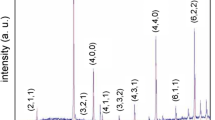Luminescent materials, activated by europium ions, with the composition SrAl2Si2O8/LaBO3 were synthesized using organosilicon compounds (methyl polysiloxane MK). The luminescence properties in red and blue LED range are characteristic of materials synthesized at 1100°C. In addition, strong luminescence is characteristic of trivalent europium ions (peaks at 591, 616, and 655 nm) in the red region of the spectrum and weak luminescence in the blue region of bivalent europium ions (peak at 405 nm). The possibility of incorporating two types of europium cations (Eu2+ and Eu3+) into the structure of synthesized polycrystalline materials makes it possible to regulate their spectral properties as a function of the conditions of synthesis.


Similar content being viewed by others
References
S. Z. Shmurak, A. P. Kiselev, N. V. Klassen, et al., “Modifications of light emission spectra and atomic structure of europium molibdate bulk crystals caused by high pressure and heat treatment,” Nuclear Sci.: IEEE Trans., 55(3), 1128 – 1132 (2008).
P. A. Loiko, G. E. Rachkovskaya, G. B. Zakharevich, K. V. Yumashev,
“New luminescing oxyfluoride glass with europium and ytterbium ions,” Steklo Keram., No. 2, 3 – 6 (2014); P. A. Loiko, G. E. Rachkovskaya, G. B. Zakharevich, K. V. Yumashev, “New luminescing oxyfluoride glass with europium and ytterbium ions,” Glass Ceram., 71(1 – 2), 41 – 44 (2014).
S. V. Lotarev, A. S. Lipat’ev, N. V. Golubev, et al., “Local crystallization of glasses aided by copper vapor laser,” Steklo Keram., No. 4, 21 – 25 (2013); S. V. Lotarev, A. S. Lipat’ev, N. V. Golubev, et al., “Local crystallization of glasses aided by copper vapor laser,” Glass Ceram., 70(3 – 4), 130 – 134 (2013).
Guojun Gao, Ning Da, Sindy Rubinsteyn, and Lothar Wondraczek, “Enchanced photoluminescence from mixed-valence Eu-doped nanocrystalline silicate glass ceramics,” Optics Express, 18(S4), A575 – 583 (2010).
E. Bernardo, L. Fiocco, G. Parcianello, et al., “Advanced ceramics from preceramic polymers modified at the nano-scale: a review,” Materials, No. 7, 1927 – 1956 (2014).
P. Greil, “Polymer derived engineering ceramics,” Adv. Eng. Mater., No. 2, 339 – 348 (2000).
E. Bernardo, P. Colombo, and S. Hampshire, “Advanced ceramics from preceramic polymers and nano-fillers,” J. Erp. Ceram. Soc., No. 29, 843 – 849 (2009).
S. S. Babu, K. Jang, E. J. Cho, et al., “Thermal, structural and optical properties of Eu3+-doped zinc-tellurite glasses,” J. Phys. D, Appl. Phys., 40(18), 5767 – 5774 (2007).
C. Zang, J. Yang, C. Lin, et al., “Reduction of Eu3+ to Eu2+ in MAl2Si2O8 (M = Ca, Sr, Ba) in air condition,” J. Solid State Chem., 182(7), 1673 – 1678 (2009).
Author information
Authors and Affiliations
Corresponding author
Additional information
Translated from Steklo i Keramika, No. 4, pp. 11 – 14, April, 2016.
Rights and permissions
About this article
Cite this article
Babakhanova, Z., Aripova, M. & Bernardo, E. The Synthesis of Luminescent Glass-Ceramic Materials Activated with Europium Ions Using Silicon-Organic Compounds (Silicones). Glass Ceram 73, 124–127 (2016). https://doi.org/10.1007/s10717-016-9839-2
Published:
Issue Date:
DOI: https://doi.org/10.1007/s10717-016-9839-2



